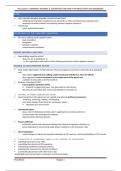Resume
Summary clinical neuropsychology: walking and cognition
- Établissement
- Vrije Universiteit Brussel (VUB)
samenvatting van de les walking and cognition gegeven door prof. Swinnen van het vak clinical neuropsychology. Het is een samenvatting van de slides van de powerpoint en extra genoteerde items van tijdens de les. De slides waren in het Engels en mijn eigen notities zijn steeds zoveel mogelijk in he...
[Montrer plus]



